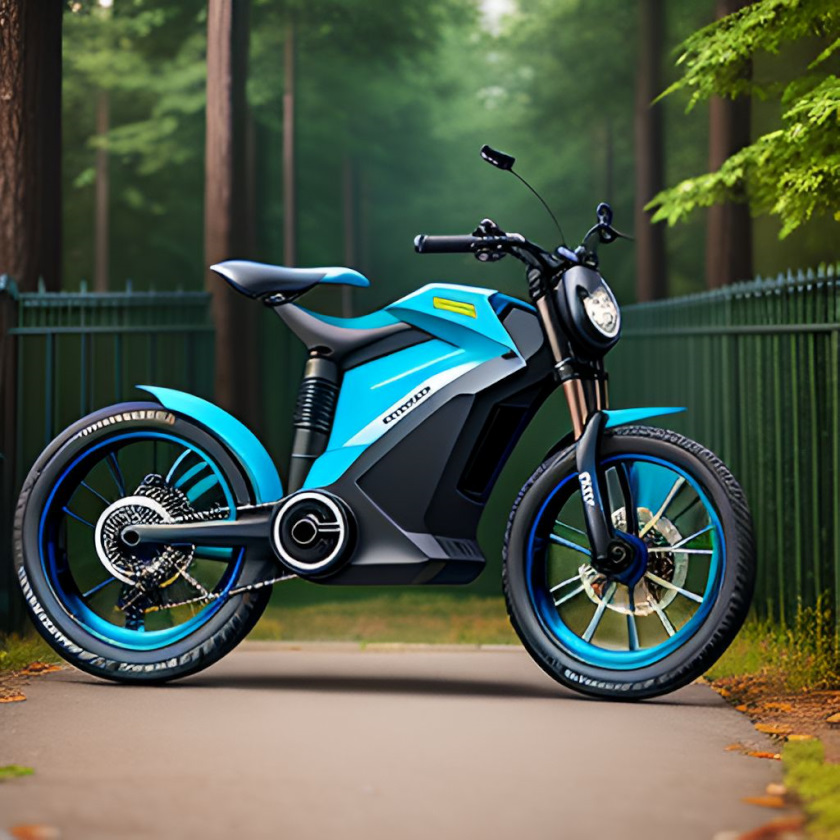Imagine effortlessly cruising through the urban streets or conquering challenging terrains with the exhilarating speed of an electric bike. Curiosity piques as you wonder, what is the fastest electric bike? Delve into the world of electrifying speed and innovative engineering as we explore the remarkable realm of electric bikes that push the boundaries of velocity. From mind-blowing performance to cutting-edge technology, prepare to be captivated by the world’s fastest electric bikes and the incredible feats they accomplish.

History of Electric Bikes
Electric bikes, also known as e-bikes, have a long and fascinating history dating back to the early 19th century. The first concept of an electric bicycle was introduced by a French inventor named Gustave Trouvé in 1881. Trouvé’s design consisted of a small electric motor housed within the front wheel hub, providing assistance to the rider’s pedaling efforts.
Early Development of Electric Bikes
In the early years, electric bikes were primarily utilized for military purposes. During the late 19th and early 20th centuries, various countries around the world began experimenting with electric bicycles to enhance mobility for soldiers in challenging terrains. However, due to the limited battery technology and inadequate speed capabilities at the time, these early electric bikes were not widely adopted.
Advancements in Electric Bike Technology
It wasn’t until the late 20th century that significant advancements in electric bike technology began to emerge. With the evolution of more powerful and efficient electric motors, as well as improvements in battery capacity and voltage, electric bikes became a viable means of transportation for the general public.
As technology continued to progress, manufacturers in the electric bike industry started to incorporate innovative features, such as regenerative braking systems and lightweight materials, to improve the overall performance and functionality of electric bikes. These advancements have played a pivotal role in transforming electric bikes into a popular choice for eco-conscious commuters and cycling enthusiasts.
Factors Affecting Electric Bike Speed
When it comes to determining the speed of an electric bike, several key factors come into play. Understanding these factors can provide valuable insights into how to maximize the performance of an electric bike.
Motor Power and Wattage
The power and wattage of the electric bike’s motor have a direct correlation to its speed. The higher the motor power, measured in watts, the faster the electric bike can potentially go. Motors with higher watt ratings can offer increased torque, allowing the bike to propel forward with greater force.
Battery Capacity and Voltage
The battery capacity and voltage also play a significant role in an electric bike’s speed capabilities. A larger battery capacity means more energy stored, enabling the motor to deliver sustained power for longer periods. Additionally, higher voltage can provide a more efficient transfer of energy from the battery to the motor, resulting in improved performance and speed.
Weight and Aerodynamics
The weight of the electric bike and its aerodynamic design can greatly impact its speed. Heavier bikes may require more energy to accelerate and maintain higher speeds, while streamlined designs can reduce wind resistance, allowing for smoother and faster rides.
Tire Type and Pressure
The type of tires and their pressure can affect the speed and overall performance of an electric bike. Wide and heavily treaded tires can create more rolling resistance, reducing speed. Conversely, thinner and smoother tires can enhance speed and efficiency by minimizing friction with the road surface.
Electric Bike Speed Limitations
While electric bikes offer an enhanced and exhilarating riding experience, there are certain limitations that affect their top speed capabilities.
Legal Restrictions
In many countries and regions, there are legal restrictions on the top speed that electric bikes can reach. These restrictions are primarily in place to ensure the safety of riders and other road users. Speed limits for electric bikes typically range from 20 to 28 miles per hour (32 to 45 kilometers per hour), depending on local regulations.
Speed Governors
Some electric bikes are equipped with speed governors, also known as limiters, which impose a maximum speed cap on the bike’s motor output. Speed governors are often implemented to comply with local regulations or to preserve battery life and ensure optimal performance.
Terrain and Riding Conditions
The terrain and riding conditions can significantly impact an electric bike’s speed. Uphill climbs, rough terrains, and adverse weather conditions can limit the speed at which an electric bike can comfortably travel. Steep inclines may also cause the motor to exert more effort, potentially reducing its maximum speed.
Types of Electric Bikes
Electric bikes come in various types, each offering unique features and capabilities to cater to different riding preferences and needs.
Pedal-Assist Electric Bikes
Pedal-assist electric bikes, commonly referred to as pedelecs, are designed to provide electric assistance while the rider is pedaling. These bikes feature sensors that detect the user’s pedaling motion and activate the motor to provide a boost of power. Pedal-assist electric bikes are a popular choice for commuters and recreational riders who want a balanced and efficient riding experience.
Throttle-Controlled Electric Bikes
Unlike pedal-assist electric bikes, throttle-controlled electric bikes allow the rider to control the motor’s power output with a throttle mechanism, similar to a motorcycle. This type of electric bike offers instant acceleration and requires minimal pedaling effort from the rider. Throttle-controlled electric bikes are often favored by riders seeking a more relaxed and effortless riding experience.
Speed Pedelecs
Speed pedelecs, also known as S-pedelecs, are a specialized category of electric bikes designed for higher speeds and increased power output. These electric bikes can reach speeds of up to 45 kilometers per hour (28 miles per hour), offering a faster alternative for commuting and longer-distance rides. Speed pedelecs typically feature a more powerful motor and larger battery capacity than traditional pedelecs.
Fastest Electric Bikes in the Market
As the demand for electric bikes continues to grow, manufacturers have been pushing the boundaries of speed performance. Here are some of the fastest electric bikes available in the market today:
Super 73 R-Series
The Super 73 R-Series is a high-performance electric bike known for its sleek design and powerful performance. With a top speed of up to 28 miles per hour (45 kilometers per hour) and a range of up to 35 miles (56 kilometers), it offers an exhilarating riding experience.
Cake Kalk OR
The Cake Kalk OR is an off-road electric bike designed for adventure enthusiasts. With its innovative design and robust motor, it can reach speeds of up to 50 miles per hour (80 kilometers per hour) and offers impressive off-road capabilities.
Specialized Turbo Vado
The Specialized Turbo Vado is a versatile electric bike that combines speed, comfort, and practicality. It can reach speeds of up to 28 miles per hour (45 kilometers per hour) and offers a range of up to 80 miles (128 kilometers), making it an ideal choice for daily commuting and longer rides.
Haibike XDURO Nduro 3.0
The Haibike XDURO Nduro 3.0 is a full-suspension electric mountain bike that excels in both speed and off-road performance. With a top speed of up to 28 miles per hour (45 kilometers per hour) and a durable frame, it offers an exhilarating riding experience on any terrain.
Riese & Müller Supercharger2
The Riese & Müller Supercharger2 is a premium electric bike known for its exceptional speed and long-range capabilities. With a top speed of up to 28 miles per hour (45 kilometers per hour) and a range of up to 160 miles (257 kilometers), it caters to riders seeking both speed and endurance.
Biktrix Juggernaut Ultra FS
The Biktrix Juggernaut Ultra FS is a powerful electric fat bike designed for off-road adventures. With its high-torque motor and top speed of up to 28 miles per hour (45 kilometers per hour), it offers a thrilling and capable riding experience on any terrain.
Stealth H-52
The Stealth H-52 is an electric bike renowned for its exceptional speed and performance. With a top speed of up to 50 miles per hour (80 kilometers per hour) and a range of up to 100 miles (160 kilometers), it is one of the fastest and longest-range electric bikes available in the market.
M55 Terminus
The M55 Terminus is a high-end electric bike that combines speed, luxury, and cutting-edge design. It boasts a top speed of up to 40 miles per hour (64 kilometers per hour) and exceptional build quality, making it a favorite among enthusiasts and collectors.
HPC Typhoon Pro
The HPC Typhoon Pro is a high-performance electric bike known for its incredible speed and power. With a top speed of up to 50 miles per hour (80 kilometers per hour) and a range of up to 80 miles (128 kilometers), it offers an exhilarating and dynamic riding experience.
Optibike R15C
The Optibike R15C is a premium electric road bike designed for speed and performance. With a top speed of up to 60 miles per hour (97 kilometers per hour), it is one of the fastest electric bikes available. The Optibike R15C offers unmatched speed and performance for riders who crave an adrenaline-filled experience.
Comparison of Fastest Electric Bikes
When considering the fastest electric bikes in the market, it’s essential to compare their key specifications. Here’s a comparison of the top speed, motor power, battery capacity, range, and price for each of these high-performance electric bikes:
Top Speed:
- Super 73 R-Series: 28 mph (45 km/h)
- Cake Kalk OR: 50 mph (80 km/h)
- Specialized Turbo Vado: 28 mph (45 km/h)
- Haibike XDURO Nduro 3.0: 28 mph (45 km/h)
- Riese & Müller Supercharger2: 28 mph (45 km/h)
- Biktrix Juggernaut Ultra FS: 28 mph (45 km/h)
- Stealth H-52: 50 mph (80 km/h)
- M55 Terminus: 40 mph (64 km/h)
- HPC Typhoon Pro: 50 mph (80 km/h)
- Optibike R15C: 60 mph (97 km/h)
Motor Power:
- Super 73 R-Series: 750W
- Cake Kalk OR: 15 kW
- Specialized Turbo Vado: 250W
- Haibike XDURO Nduro 3.0: 250W
- Riese & Müller Supercharger2: 250W
- Biktrix Juggernaut Ultra FS: 750W
- Stealth H-52: 5.2 kW
- M55 Terminus: 2.8 kW
- HPC Typhoon Pro: 5 kW
- Optibike R15C: 6 kW
Battery Capacity:
- Super 73 R-Series: 960Wh
- Cake Kalk OR: 2.6 kWh
- Specialized Turbo Vado: 604Wh
- Haibike XDURO Nduro 3.0: 500Wh
- Riese & Müller Supercharger2: 1,000Wh
- Biktrix Juggernaut Ultra FS: 1,125Wh
- Stealth H-52: 2.5 kWh
- M55 Terminus: 1.55 kWh
- HPC Typhoon Pro: 1.25 kWh
- Optibike R15C: 1.52 kWh
Range:
- Super 73 R-Series: 35 miles (56 km)
- Cake Kalk OR: 50 miles (80 km)
- Specialized Turbo Vado: 80 miles (128 km)
- Haibike XDURO Nduro 3.0: 70 miles (113 km)
- Riese & Müller Supercharger2: 160 miles (257 km)
- Biktrix Juggernaut Ultra FS: 80 miles (128 km)
- Stealth H-52: 100 miles (160 km)
- M55 Terminus: 75 miles (120 km)
- HPC Typhoon Pro: 80 miles (128 km)
- Optibike R15C: 100 miles (160 km)
Price:
- Super 73 R-Series: $2,200
- Cake Kalk OR: $14,000
- Specialized Turbo Vado: $4,600
- Haibike XDURO Nduro 3.0: $6,800
- Riese & Müller Supercharger2: $7,800
- Biktrix Juggernaut Ultra FS: $5,200
- Stealth H-52: $10,900
- M55 Terminus: $17,900
- HPC Typhoon Pro: $13,500
- Optibike R15C: $16,995

Future Trends in Electric Bike Speed
As technology continues to evolve, the future of electric bike speed looks promising. Here are some anticipated trends that may shape the future of electric bike speed:
Advancements in Motor Technology
With ongoing advancements in motor technology, electric bike motors are expected to become more powerful and efficient. This could result in higher top speeds and improved acceleration capabilities.
Improvements in Battery Performance
Battery technology continues to progress, leading to advancements in energy density and charging capabilities. Future electric bikes may benefit from lighter and more powerful batteries, allowing for increased speed while maintaining optimal range.
Lightweight Materials and Design
The use of lightweight materials, such as carbon fiber and aluminum alloys, is becoming more prevalent in the electric bike industry. As electric bikes become lighter and more aerodynamic, riders can expect enhanced speed performance.
Integration of Electric Bike Systems
Manufacturers are increasingly integrating electric bike systems, including the motor, battery, and control systems, to improve overall efficiency and performance. This integration can lead to smoother power delivery and potentially higher top speeds.
Regulatory Changes
Regulations regarding electric bikes are subject to change as the industry continues to mature. As governments and transportation authorities become more familiar with electric bike technology, it’s possible that speed restrictions may be revised or updated in certain regions, allowing for faster electric bike models.
Conclusion
The history of electric bikes showcases the evolution and progress of this innovative form of transportation. With advancements in technology, electric bikes have become popular for their convenience, eco-friendliness, and potential for increased speed. Factors affecting electric bike speed include motor power, battery capacity, weight, and aerodynamics. Speed limitations can arise from legal restrictions, speed governors, and terrain conditions. Electric bikes come in various types, including pedal-assist, throttle-controlled, and speed pedelecs, catering to different riding preferences. The market offers a range of fast electric bikes, each with unique features and performance capabilities. Future trends in electric bike speed are likely to focus on advancements in motor technology, battery performance, lightweight materials, integration of electric bike systems, and potential regulatory changes. Whether you’re a commuter or a thrill-seeking rider, the world of electric bikes offers exciting possibilities for faster and more exhilarating rides. So, hop on your electric bike and experience the thrill of speed while enjoying the benefits of eco-friendly transportation.


